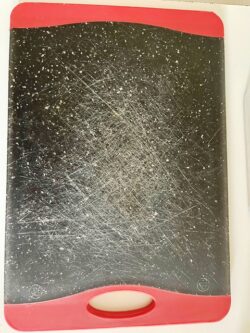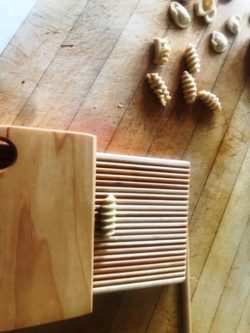Read Time: 5 Minutes Subscribe & Share
Science Project
 Some time in the latter part of the 20th century – and I have been unable to find the exact date – a rather fuzzy guideline was issued by the US Department of Agriculture stating that food service facilities should switch from wood cutting boards to plastic. Of course, with this announcement blaring on newscasts and articles written in food and health columns, many people at home frantically followed suit. It was difficult to sell a wood cutting board in the shop or install a wood kitchen counter. I too bought a few cutting boards of different types of plastic. But over time, I thought they felt harder than wood when I chopped food on them. And I noticed some shredded grooves in them after continued use. They just seemed not quite right for the job, and I continued to use wood boards for dicing and slicing…although there would be occasional ominous comments from certain people in my home.
Some time in the latter part of the 20th century – and I have been unable to find the exact date – a rather fuzzy guideline was issued by the US Department of Agriculture stating that food service facilities should switch from wood cutting boards to plastic. Of course, with this announcement blaring on newscasts and articles written in food and health columns, many people at home frantically followed suit. It was difficult to sell a wood cutting board in the shop or install a wood kitchen counter. I too bought a few cutting boards of different types of plastic. But over time, I thought they felt harder than wood when I chopped food on them. And I noticed some shredded grooves in them after continued use. They just seemed not quite right for the job, and I continued to use wood boards for dicing and slicing…although there would be occasional ominous comments from certain people in my home.
Previously, having been ignorant of the suggested ban on wood cutting surfaces, I had installed a beautiful and functional several-feet-long wood countertop in my kitchen by Bally Block. This company also made beautiful and functional cutting boards that we sold in the shop. Interestingly, Bally Block got its start making wood propellers for airplanes, much like BMW in Germany got its start making airplane engines. Today they limit their production to residential and commercial wood countertops. While mine was made of maple, Bally offers several other types of wood, including teak, walnut, cherry, oak and, surprising to me, eucalyptus.
beautiful and functional several-feet-long wood countertop in my kitchen by Bally Block. This company also made beautiful and functional cutting boards that we sold in the shop. Interestingly, Bally Block got its start making wood propellers for airplanes, much like BMW in Germany got its start making airplane engines. Today they limit their production to residential and commercial wood countertops. While mine was made of maple, Bally offers several other types of wood, including teak, walnut, cherry, oak and, surprising to me, eucalyptus.
It turns out that eucalyptus is a fast-growing and easily renewable wood. One could say that it is “farmed” on plantations, and there are a number of eucalyptus growers who provide certified sustainably grown eucalyptus timber. It is an extremely hard and dense wood, so it resists chipping and splintering. And for those of you who are still terrified of bacteria on cutting surfaces, eucalyptus has antimicrobial properties superior to other woods. Oak, cherry, pine for example, are softer woods and should not be used as chopping boards.
Bally only uses edge-grain wood in its counter tops, that is the grain that shows when a log is cut vertically. Edge grain boards actually make for a softer landing surface for your knife and wrist. End grain boards that laminate pieces of wood cut horizontally provide a harder surface. End-grain boards can look prettier, with different patterns showing off in a checkerboard look, but they require more oiling than edge-grain boards as the oil gets absorbed more quickly into end-grain cuts.
Doing The Homework
Which goes back to the interesting warning on wood as a culinary cutting surface. Apparently, there was no scientific study made to back up the mandate that commercial kitchens had to switch to plastic work surfaces. It just “seemed” to make sense. Dean Oliver, a food researcher at UC Davis in California, produced a stunning study that challenges that so-called common sense with science:
Our research was first intended to develop means of disinfecting wooden cutting surfaces at home, so that they would be almost as safe as plastics. Our safety concern was that bacteria such as Escherichia Coli O157:H7 and Salmonella, which might contaminate a work surface when raw meat was being prepared, ought not remain on the surface to contaminate other foods that might be eaten without further cooking. We soon found that disease bacteria such as these were not recoverable from wooden surfaces in a short time after they were applied, unless very large numbers were used. New plastic surfaces allowed the bacteria to persist, but were easily cleaned and disinfected. However, wooden boards that had been used and had many knife cuts acted almost the same as new wood, whereas plastic surfaces that were knife-scarred were impossible to clean and disinfect manually, especially when food residues such as chicken fat were present. Scanning electron micrographs revealed highly significant damage to plastic surfaces from knife cuts.
Now, certain studies have shown that plastic cutting boards also may add to the microplastics savings account we have in our bodies. Most of the microplastics found in meat were from the plastic cutting boards used in commercial facilities. An intriguing fact that came up in the studies was that frying meat melted out some of the microplastic presence, and that washing meat three minutes or longer also reduced its presence. This does make my beloved fried chicken in bacon grease look positively healthy, but I can’t imagine bathing my steak for longer than I am in the shower.
Cleaning & Caring
 Proper and regular cleaning, though, for any cutting surface that you choose is of utmost importance. Joe Raffa, the chef from Jose Andres Think Food Group who ran our knife skills classes, always advised using the following solution for cleaning any board. It also gets rid of the garlic flavor if you next use your board for cutting strawberries! He used a tablespoon of unscented liquid chlorine bleach in a gallon of water (so about 3/4 teaspoon to a quart). You can put it in a spray bottle if you prefer. Either spray generously onto the surface or douse your cleaning cloth into the solution and wipe the wood thoroughly. Allow it to stand for a few minutes, then thoroughly rinse or wipe generously with a clean cloth soaked in tap water. Dry with paper towels or dishcloth.
Proper and regular cleaning, though, for any cutting surface that you choose is of utmost importance. Joe Raffa, the chef from Jose Andres Think Food Group who ran our knife skills classes, always advised using the following solution for cleaning any board. It also gets rid of the garlic flavor if you next use your board for cutting strawberries! He used a tablespoon of unscented liquid chlorine bleach in a gallon of water (so about 3/4 teaspoon to a quart). You can put it in a spray bottle if you prefer. Either spray generously onto the surface or douse your cleaning cloth into the solution and wipe the wood thoroughly. Allow it to stand for a few minutes, then thoroughly rinse or wipe generously with a clean cloth soaked in tap water. Dry with paper towels or dishcloth.
In terms of longevity, you can’t beat wood for standing the test of time. Like copper pans that can be relined instead of being replaced, wood can be repeatedly sanded and oiled to get rid of burns (something I have been quite guilty of) and blemishes. Oiling them with a mineral oil once a week for a month after purchase, once a month for a year, and once a year thereafter is the old adage that has certainly worked for me. Now I just need to find some Eucalyptus in Italy….

Kitchen Detail shares under the radar recipes, explores the art of cooking, the stories behind food, and the tools that bring it all together, while uncovering the social, political, and environmental truths that shape our culinary world.




When I had my home baking business, I had a large NSF steel table where I worked with bread dough and other food products. Now retired, I have a large slab of tight-grained butcher block at one end of an 1860’s English pine farm table. This slab was the cut out when the I installed butcher block countertops, and the glass stovetop left a fine piece (20X32) of wood that morphed into the best work surface. I seal it once per year with Ikea’s water based and food safe sealer. I cannot imagine using bleach on a wood block. I… Read more »
I don’t know the exact date either, Nancy, but believe it was a University of Wisconsin study which started the whole mess. It seemed a marvel that everyone using wood cutting surfaces for the thousands of years preceding this study weren’t all sick or dead.
I also noticed the plastic cutting boards felt harder and were a bit slick when new and had liquid on them (such as when cutting tomatoes or some other juicy bit). So, like you, I stayed with wooden boards.